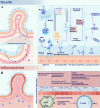Gut virome and its implications in the pathogenesis and therapeutics of inflammatory bowel disease
- PMID: 40140901
- PMCID: PMC11948845
- DOI: 10.1186/s12916-025-04016-y
Gut virome and its implications in the pathogenesis and therapeutics of inflammatory bowel disease
Abstract
Inflammatory bowel disease (IBD) refers to chronic, recurrent inflammatory intestinal disorders, primarily including Crohn's disease (CD) and Ulcerative colitis (UC). Numerous studies have elucidated the importance of the gut microbiome in IBD. Recently, numerous studies have focused on the gut virome, an intriguing and enigmatic aspect of the gut microbiome. Alterations in the composition of phages, eukaryotic viruses, and human endogenous retroviruses that occur in IBD suggest potential involvement of the gut virome in IBD. Nevertheless, the mechanisms by which it maintains intestinal homeostasis and interacts with diseases are only beginning to be understood. Here, we thoroughly reviewed the composition of the gut virome in both healthy individuals and IBD patients, emphasizing the key viruses implicated in the onset and progression of IBD. Furthermore, the complex connections between the gut virome and the intestinal barrier, immunity, and gut microbiome were dissected to advance the interpretation of IBD pathogenesis. The updated discussion of the evidence regarding the gut virome will advance our knowledge in gut virome and chronic gastrointestinal diseases. Targeting the gut virome is a promising avenue for IBD treatment in future.
Keywords: Crohn’s disease (CD); Eukaryotic gut virome; Fecal virome transplantation; Gut virome-host interactions; Inflammatory bowel disease (IBD); Phage; Ulcerative colitis (UC).
© 2025. The Author(s).
Conflict of interest statement
Declarations. Ethics approval and consent to participate: Not applicable. Consent for publication: Not applicable. Competing interests: The authors declare no competing interests.
Figures



Similar articles
-
Gut virome-wide association analysis identifies cross-population viral signatures for inflammatory bowel disease.Microbiome. 2024 Jul 18;12(1):130. doi: 10.1186/s40168-024-01832-x. Microbiome. 2024. PMID: 39026313 Free PMC article.
-
Whole-Virome Analysis Sheds Light on Viral Dark Matter in Inflammatory Bowel Disease.Cell Host Microbe. 2019 Dec 11;26(6):764-778.e5. doi: 10.1016/j.chom.2019.10.009. Epub 2019 Nov 19. Cell Host Microbe. 2019. PMID: 31757768
-
A systematic review on the role of gut microbiome in inflammatory bowel disease: Spotlight on virome and plant metabolites.Microb Pathog. 2025 Aug;205:107608. doi: 10.1016/j.micpath.2025.107608. Epub 2025 Apr 16. Microb Pathog. 2025. PMID: 40250496
-
Transplantation of bacteriophages from ulcerative colitis patients shifts the gut bacteriome and exacerbates the severity of DSS colitis.Microbiome. 2022 Jul 8;10(1):105. doi: 10.1186/s40168-022-01275-2. Microbiome. 2022. PMID: 35799219 Free PMC article.
-
Microbiome-phage interactions in inflammatory bowel disease.Clin Microbiol Infect. 2023 Jun;29(6):682-688. doi: 10.1016/j.cmi.2022.08.027. Epub 2022 Oct 1. Clin Microbiol Infect. 2023. PMID: 36191844 Review.
Cited by
-
Integrated transcriptomic and proteomic profiling of colonic tissue in interleukin-10-deficient mice.Sci Data. 2025 Jul 1;12(1):1109. doi: 10.1038/s41597-025-05212-4. Sci Data. 2025. PMID: 40593797 Free PMC article.
References
-
- Ng SC, Shi HY, Hamidi N, Underwood FE, Tang W, Benchimol EI, et al. Worldwide incidence and prevalence of inflammatory bowel disease in the 21st century: a systematic review of population-based studies. Lancet. 2017;390(10114):2769–78. - PubMed
-
- Li L, Cheng R, Wu Y, Lin H, Gan H, Zhang H. Diagnosis and management of inflammatory bowel disease. J Evid Based Med. 2024;17(2):409–33. - PubMed
Publication types
MeSH terms
Grants and funding
LinkOut - more resources
Full Text Sources

